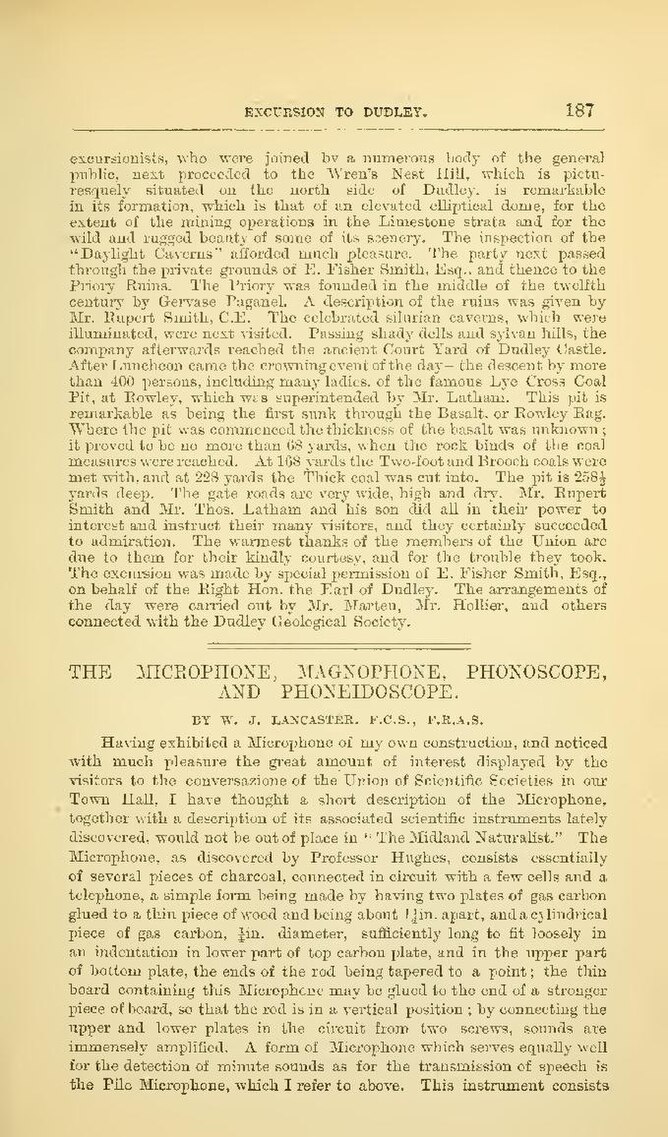excursionists, who were joined by a numerous body of the general public, next proceeded to the Wren’s Nest Hill, which is picturesquely situated on the north side of Dudley. is remarkable in its formation, which is that of an elevated elliptical dome, for the extent of the mining operations in the Limestone strata and for the wild and rugged beauty of saine of its scenery. The inspection of the "Daylight Caverns" afforded much pleasure. The party next passed through the private grounds of E. Fisher Smith, Esq., and thence to the Priory Ruins. The Priory was founded in the middle of the twelfth century by Gervase Paganel. A description of the ruins was given by Mr. Rupert Smith, C.E. The celebrated silurian caverns, which were illuminated, were nest visited. Passing shady dells and sylvan hills, the company afterwards reached the ancient Court Yard of Dudley Castle. After Luncheon came the crowning event of the day— the descent by more than 400 persons, including many ladies, of the famous Lye Cross Coal Pit, at Rowley, which was superintended by Mr. Latham. This pit is remarkable as being the first sunk through the Basalt, or Rowley Rug. Where the pit was commenced the thickness of the basalt was unknown; it proved to be no more than 68 yards, when the rock binds of the coal measures were reached. At 168 yards the Two-foot and Brooch coals were met with, and at 228 yards the Thick coal was cut into. The pit is 258½ yards deep. The gate roads are very wide, high and dry. Mr. Rupert Smith and Mr. Thos. Latham and his son did all in their power to interest and instruct their many visitors, and they certainly succeeded to admiration, The warmest thanks of the members of the Union are due to them for their kindly courtesy, and for the trouble they took. The excursion was made by special permission of E. Fisher Smith, Esq., on behalf of the Right Hon. the Earl of Dudley. The arrangements of the day were carried out by Mr. Marten, Mr. Hollier, and others connected with the Dudley Geological Society.
The Microphone, Magnophone, Phonoscope, and Phoneidoscope.
By W. J. Lancaster. F.C.S., F.R.A.S.
Having exhibited a Microphone of my own construction, and noticed with much pleasure the great amount of interest displayed by the visitors to the conversazione of the Union of Scientific Societies in our Town Hall, I have thought a short description of the Microphone, together with a description of its associated scientific instruments lately discovered, would not be out of place in "The Midland Naturalist." The Microphone, as discovered by Professor Hughes, consists essentially of several pieces of charcoal, connected in circuit with a few cells and a telephone, a simple form being made by heaving two plates of gas carbon glued to a thin piece of wood and being about 1¼in. apart, and a cylindrical piece of gag carbon, ¼in. diameter, sufficiently long to fit loosely in an indentation in lower part of top carbon plate, and in the upper part of bottom plate, the ends of the red being tapered to a point; the thin board containing this Microphone may be glued to the end of a stronger piece of board, so that the red is in a vertical position; by connecting the upper and lower plates in the circuit from two screws, sounds are immensely amplified. A form of Microphone which serves equally well for the detection of minute sounds as for the transmission of speech to the Pile Microphone, which I refer to above. This instrument consists
